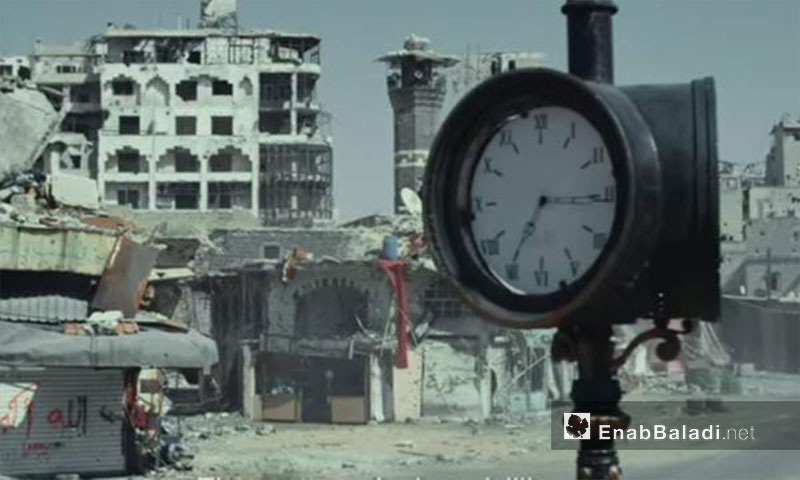During the three years of the revolution, Al-khouri François van der Logitte, nicknamed “Abu Michel”, did not stop allocating part of the aid of the Church of Peace in the Homs neighborhood of Hamidiya to the opposition areas which were rebellious against the Syrian regime andwhich witnessed almost daily mass demonstrations.
But the odd name of al-Khouri, born to a Dutch father, may have been a hindrance to Joud Said, the director of Homs Rain, to be presented in his film, so he replaced it with another character that protects civilians from the evil “terrorist” opposition.
“Homs Rain” is a brainwashing attempt
War cinema that Joud presents today needs some of these cases, such as field execution and the like. It may be a wasted effort to create the scene of the killing of al-Khoury by the “terrorists” in the cemetery of Homs, if only he did not ignore the killing of “Abu Michel” by a Christian recruited by the Syrian regime to carry out the mission, and throwing his lifeless body in front of Umm al-Zanar church in al-Hamidiya neighborhood in April 2014, as people of Homs told Enab Baladi, denying the regime’s rumour about his death by snipers of the opposition forces.
“The smell of Homs today brings me back to childhood in Beirut,” Said told al Akhbar Lebanese newspaper, which is close to the Syrian regime. The two ignored the massacres of the two Assad presidents in Lebanon, from Tel al-Zaatar to car bombs in which his involvement with his agents in Beirut such as Michel Samaha, has been proven.
Said focused on Homs clock, which hundreds of rebels against the Syrian regime died in order to reach and sit-in in front of it. Yet, al Akhbar dared to ignore the Lebanese victims while referring to these events. The director said “Let’s share the identity of the clock at least,” as for the victims and the innocent people, this is another issue, just a view. That civilians die by the atrocities of the regime’s army and militias is mere a point of view to Said.
“Homs Rain” was not implicated with the memory of the Syrians only, but entered into bidding with the media of the regime. The government newspaper Tishreen denied in an article that the regime’s army had been besieged in Homs, asserting that it is al-Assad forces that besieged the opposition, and undermining the entire hypothesis of Joud Said about the tortures of civilians at the hands of their terrorist captors.
It seems that Tishreen newspaper refused out of self-esteem, that the army of the regime it supports is belittled. The reality is that it is unjust even with the people it claims to protect. While waiting for the completion of the Joud Said Triad about the siege of other civilians in the Latakia and Aleppo villages, we are confused about the dilemma created by the regime newspaper and what he would say this time. Would he say that civilians were committing suicide because they miss the regime barriers that cut off water and food and besieged them in their cities and villages?
“Rad El Qadhaa” film from Darayya to Aleppo Central Prison
Tishreen newspaper did not say the whole truth. Its blame about the misuse of Homs as a setting for events wherein the film director made many mistakes was not applied to the film “Rad El Qadhaa” by Nejdat Anzour, the designated head of the People’s Council.
Anzour, who dealt with the siege of Aleppo Central Prison, filmed the scenes of his film in Darayya, which the regime has besieged for years with the Lebanese Hezbollah militia until scenes of famine and pouring barrel bombs were spread everywhere.
Not only did the Head of the People’s Council distort the truth, but he used the crime theatre and organized dead bodies and perpetrators so that the murderer appears oppressed and soft-hearted in front of the ugliness of its victims blood.
Did Anzour forget to speak about the sufferings of Christians by Muslim “terrorists” according to the world’s common pattern?
He probably did not forget, but the videos that documented the first months of the revolution in the city of Darayya revealed unequivocally the participation of churches and Christians in the funeral of the city’s Muslim martyrs and their reception of the wounded and funerals like in Homs, that Joud Said does not know.
Today we are waiting for a new film from al-Assad Cinema, to see who will talk about the looting of the regime’s army of the Church of Umm al-Zanar in al-Hamidiya neighbourhood of Homs and who will talk about the killing of Bassel Shehadeh, one of the most famous figures of the revolution in the city. Who will convey to the world scenes of the security alert in Damascus and the siege of his home and preventing the mourners from going to the Roman Catholic Church in al-Qassaa to pray for his soul while his fellows in Homs buried him with his friends who were killed by an air raid of the regime on Bab Alsebaa in 2012.
